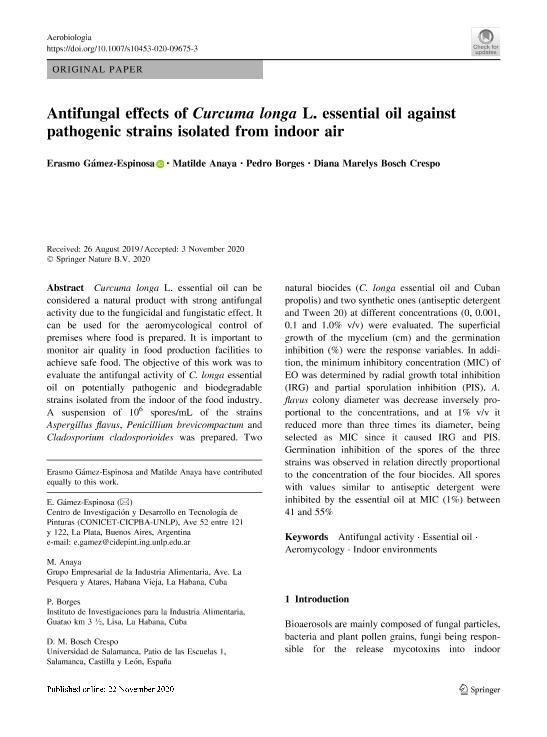Mostrar el registro sencillo del ítem
dc.contributor.author
Gámez Espinosa, Erasmo Junior

dc.contributor.author
Anaya, Matilde
dc.contributor.author
Borges, Pedro
dc.contributor.author
Bosch Crespo, Diana Marelys

dc.date.available
2021-11-11T19:03:20Z
dc.date.issued
2020-11
dc.identifier.citation
Gámez Espinosa, Erasmo Junior; Anaya, Matilde; Borges, Pedro; Bosch Crespo, Diana Marelys; Antifungal effects of Curcuma longa L. essential oil against pathogenic strains isolated from indoor air; Springer; Aerobiologia; 37; 1; 11-2020; 119-126
dc.identifier.issn
0393-5965
dc.identifier.uri
http://hdl.handle.net/11336/146749
dc.description.abstract
Curcuma longa L. essential oil can be considered a natural product with strong antifungal activity due to the fungicidal and fungistatic effect. It can be used for the aeromycological control of premises where food is prepared. It is important to monitor air quality in food production facilities to achieve safe food. The objective of this work was to evaluate the antifungal activity of C. longa essential oil on potentially pathogenic and biodegradable strains isolated from the indoor of the food industry. A suspension of 106 spores/mL of the strains Aspergillus flavus, Penicillium brevicompactum and Cladosporium cladosporioides was prepared. Two natural biocides (C. longa essential oil and Cuban propolis) and two synthetic ones (antiseptic detergent and Tween 20) at different concentrations (0, 0.001, 0.1 and 1.0% v/v) were evaluated. The superficial growth of the mycelium (cm) and the germination inhibition (%) were the response variables. In addition, the minimum inhibitory concentration (MIC) of EO was determined by radial growth total inhibition (IRG) and partial sporulation inhibition (PIS). A. flavus colony diameter was decrease inversely proportional to the concentrations, and at 1% v/v it reduced more than three times its diameter, being selected as MIC since it caused IRG and PIS. Germination inhibition of the spores of the three strains was observed in relation directly proportional to the concentration of the four biocides. All spores with values similar to antiseptic detergent were inhibited by the essential oil at MIC (1%) between 41 and 55%
dc.format
application/pdf
dc.language.iso
eng
dc.publisher
Springer

dc.rights
info:eu-repo/semantics/openAccess
dc.rights.uri
https://creativecommons.org/licenses/by-nc-sa/2.5/ar/
dc.subject
AEROMYCOLOGY
dc.subject
ANTIFUNGAL ACTIVITY
dc.subject
ESSENTIAL OIL
dc.subject
INDOOR ENVIRONMENTS
dc.subject.classification
Micología

dc.subject.classification
Ciencias Biológicas

dc.subject.classification
CIENCIAS NATURALES Y EXACTAS

dc.title
Antifungal effects of Curcuma longa L. essential oil against pathogenic strains isolated from indoor air
dc.type
info:eu-repo/semantics/article
dc.type
info:ar-repo/semantics/artículo
dc.type
info:eu-repo/semantics/publishedVersion
dc.date.updated
2021-09-06T17:07:36Z
dc.journal.volume
37
dc.journal.number
1
dc.journal.pagination
119-126
dc.journal.pais
Alemania

dc.journal.ciudad
Berlin
dc.description.fil
Fil: Gámez Espinosa, Erasmo Junior. Provincia de Buenos Aires. Gobernación. Comisión de Investigaciones Científicas. Centro de Investigaciones en Tecnología de Pinturas. Consejo Nacional de Investigaciones Científicas y Técnicas. Centro Científico Tecnológico Conicet - La Plata. Centro de Investigaciones en Tecnología de Pinturas; Argentina
dc.description.fil
Fil: Anaya, Matilde. Instituto de Investigaciones Para la Industria Alimentaria; Cuba
dc.description.fil
Fil: Borges, Pedro. Instituto de Investigaciones Para la Industria Alimentaria; Cuba
dc.description.fil
Fil: Bosch Crespo, Diana Marelys. Universidad de Salamanca; España
dc.journal.title
Aerobiologia

dc.relation.alternativeid
info:eu-repo/semantics/altIdentifier/url/http://link.springer.com/10.1007/s10453-020-09675-3
dc.relation.alternativeid
info:eu-repo/semantics/altIdentifier/doi/http://dx.doi.org/10.1007/s10453-020-09675-3
Archivos asociados
